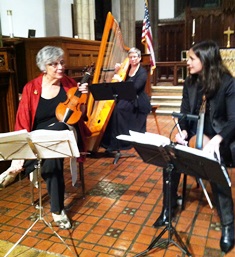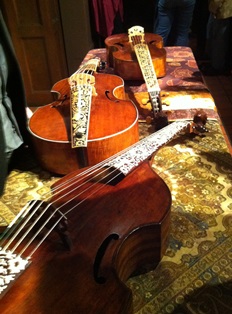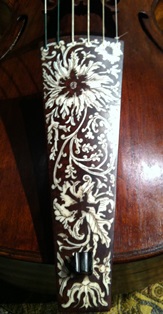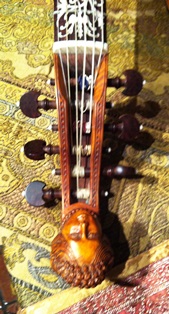
Catacoustic Consort Marries Music and Art


The dual message of the Constella Festival of Music and Fine Arts came together beautifully in Catacoustic Consort’s opening concert of the season Saturday night at Church of the Advent in Walnut Hills.
Cincinnati’s Catacoustic Consort is one of the 2013 Festival’s partner organizations, and early music lovers were there in force to enjoy a program of viola da gamba music featuring famed gambist Catharina Meints and to view instruments from the important Caldwell Collection of Viols, which she and her late husband James Caldwell assembled over the years.
Making it extra special, seven viols from the collection – second largest in the world and the only one in which all of the instruments are playable – were performed during the concert. Joining Meints, a faculty member of the Oberlin Conservatory, were gambist/Catacoustic artistic director Annalisa Pappano, lutenist David Walker and harpist Elizabeth Motter.


Six bass violas da gamba and one pardessus de viole, stunning works of art by some of the greatest viol makers from the 17th and 18th centuries, were available for inspection in the nave of the church during intermission and after the concert. From handsome scroll work and decorative fingerboards to intricately carved designs on the bodies of the instruments, it was an awe-inspiring display, the more so when one heard the sounds they produce. Meints (a former teacher of Pappano), spoke about the instruments between numbers and about how she and her husband found, researched and restored them.
The program was divided into three parts, representing the English, German and French schools of viol playing and composition. Meints pointed out how they differ. The English school, with viol makers like John Rose and Barak Norman, is characterized by “clarity, transparency and lightness,” she said. The German sound – Joachim Tielke, for example (“the Antonio Stradivari of the viol”) – “is warmer, fatter, and more in-your-face.” The French, including makers like Louis Guersan and Nicolas Bertrand, she described as like “a laser beam surrounded by smoke.”
All of this was exquisitely captured in music by John Jenkins (English), Georg Phillip Telemann (German), and Frenchmen Charles Dollé and Marin Marais (the latter subject of the 1991 film “Tous les matins du monde” starring Gérard Depardieu).
Meints and Pappano on bass viols (a 1600 Rose and 1692 Norman, respectively) and Walker on theorbo (a long-necked bass lute), demonstrated the English school with Two Aires from Six Aires and Divisions by Jenkins (an early baroque composer who lived to be 86 despite the English civil wars). No. 3 was light and lively, while No. 4 began on a more solemn note.
For Sonata in A Minor by Telemann, Meints and Pappano both played Tielke bass viols. (Meints’ 1685 instrument has quite a history, she said, having once been turned into a cello.) This work demonstrated Ments’ virtuosity (her lines dominated the texture), particularly in the Allegro finale, where she was all over the instrument. She and Pappano produced a lovely, warm sound in the opening Largo.
After intermission, the two gambists turned to the pardessus (a cross between the viol and the violin, created to be played by French aristocrats, particularly women, in the 18th century). One’s first impression of the pardessus is always its sweet sound, but the four-movement Sonata II by Dollé, was anything but easy. (To begin with, the five-string pardessus is tuned partly in fifths and partly in fourths, meaning an adjustment for players trained to play in one or the other.) Dollé’ makes equal demands on the two instruments, and in addition to their sweetness of sound, it was quite impressive to hear the two artists handle their small instruments so nimbly.
Meints and Pappano were again joined by Walker in Marais’ well known “Tombeau de Mr. Meliton” for bass viols and continuo. Meints played a seven-stringed French viol, ca. 1680, by Bertrand, Pappano, a modern reproduction. The two players shaped this deeply affecting work beautifully, from its heart-wrenching passages to its quiet, resigned ending. They followed with more Marais, a Chaconne, with lutenist Walker and Motter on baroque harp. This good natured, happy work made a nice contrast with the mournful “Tombeau,” bringing the thoroughly enjoyable concert to an upbeat end.
There was considerable mixing after the program, as
listeners stayed to marvel at the instruments and ask questions of the performers. Many also examined Meints’ new book “The
Caldwell Collection of Viols: A Life Together in the Pursuit of Beauty,” signed
by the author and available for sale.
The concert was dedicated to violist/gambist, Catacoustic fan and all-around music lover Allen Martin, a member of the Cincinnati Symphony Orchestra for thirty years, who died October 22.